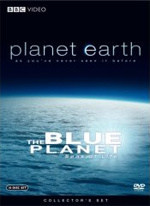 The Blue Planet and Planet Earth are among the finest nature documentaries you could ever hope to see. Produced by the BBC and narrated by David Attenborough, the first looks to the world’s oceans and the second primarily to its land masses.
The Blue Planet and Planet Earth are among the finest nature documentaries you could ever hope to see. Produced by the BBC and narrated by David Attenborough, the first looks to the world’s oceans and the second primarily to its land masses.
The Blue Planet (first broadcast in 2001) is comprised of eight 50-minute episodes. As Attenborough explains in the opening moments, “Our planet is a blue planet: over seventy percent of it is covered by the sea. The Pacific Ocean alone covers half the globe. You can fly across it non-stop for twelve hours and still see nothing more than a speck of land. This series will reveal the complete natural history of our ocean planet, from its familiar shores to the mysteries of its deepest seas.” The first episode is something of a summary and each of the other seven looks to a specific aspect of the planet’s water—from the strange life that lurks in its deepest depths to the life that crawls from water to land with each receding tide.
There are several extras on the DVDs and they are of varying quality (though none rises to the standards of the actual episodes). Several of them are of feature length—50 minutes or so. The most interesting of the extras are probably the short “how it was made” clips which explain how the filmmakers managed to capture some of the incredible shots, many of which recorded behavior that has never before been captured by cameras.
Planet Earth (first broadcast in 2006) is comprised of eleven episodes and follows a similar format. Says Attenborough, “A hundred years ago, there were one and a half billion people on Earth. Now, over six billion crowd our fragile planet. But even so, there are still places barely touched by humanity. This series will take you to the last wildernesses and show you the planet and its wildlife as you have never seen them before.” The first episode journeys from the top of the world to the bottom and stops many places in between. Further episodes narrow in on specific features or terrain. As with The Blue Planet each episode is around 50 minutes in length and is followed by a 10 minute “Planet Earth Diary” which follows the filmmakers as they record the incredible shots.
The series is supplemented by three episodes which together are known as Planet Earth: The Future. This is a mixture of helpful environmental whistle-blowing and silly near-panic about overpopulation and global warming. While enjoyable as bonus features, they are not of the quality of the featured presentation.
Whether these are films you’d like to enjoy with your whole family will depend on how comfortable you are with seeing lots and lots of animals eating other animals and lots and lots of animalian hanky panky. If your children have grown up on a farm, there will be nothing new here; if they’ve grown up in suburbs you may have some explaining to do from time-to-time. And, of course, there is the unspoken assumption throughout that Darwinian evolution best explains the origins of all of this planet’s life.
Both series are excellent and often breathtaking. I watched them with my wife and we were both left gasping at times. The quality of these productions is unparalleled. I do not know what more to say—I have never seen anything like these. Where the filmmakers may have seen and announced the triumph of evolution, we saw the hand of a Creator who lovingly and painstakingly built this world with an abundance and a stunning variety of life. I could not watch without voicing praise to the Creator whose handiwork is so evident in all of creation. This series is an incredible testimony to His power.
While the series are sold separately, I chose to purchase them together in the “Special Collector’s Edition.” Those with top-notch home theaters may want to purchase Planet Earth in HD-DVD or Blu Ray. If you are going to purchase only one of the series, I’d recommend Planet Earth. But either or both will make excellent additions to your collection. You’ll watch them time and again.








